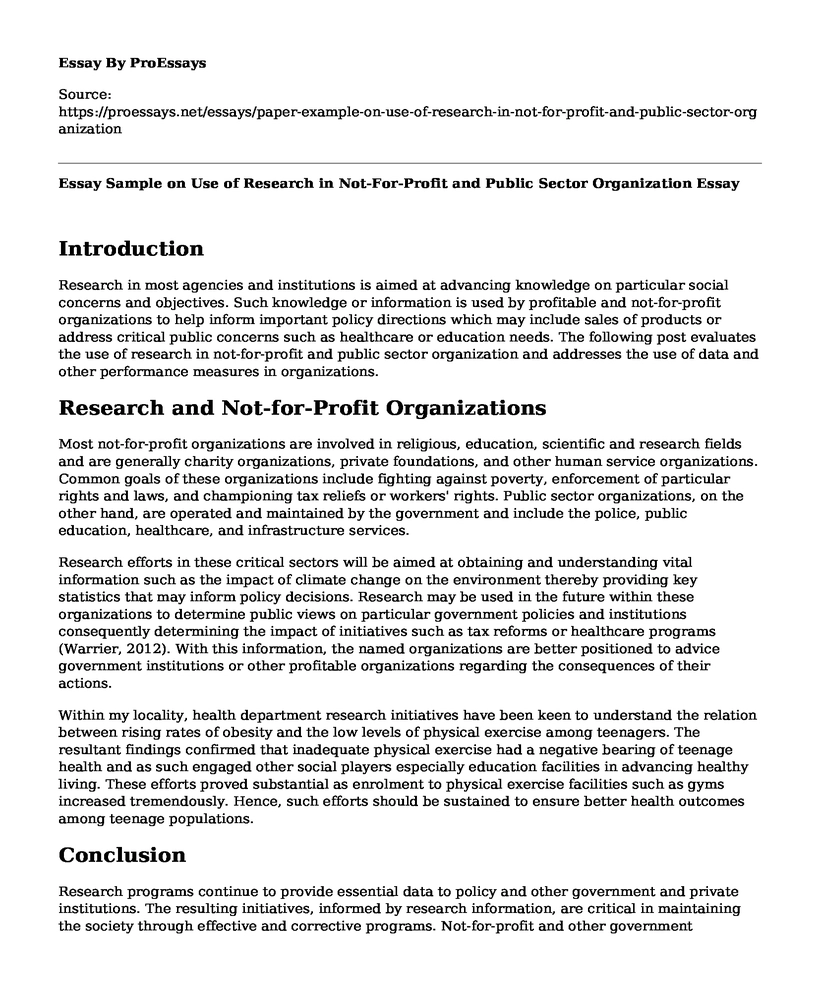Introduction
Research in most agencies and institutions is aimed at advancing knowledge on particular social concerns and objectives. Such knowledge or information is used by profitable and not-for-profit organizations to help inform important policy directions which may include sales of products or address critical public concerns such as healthcare or education needs. The following post evaluates the use of research in not-for-profit and public sector organization and addresses the use of data and other performance measures in organizations.
Research and Not-for-Profit Organizations
Most not-for-profit organizations are involved in religious, education, scientific and research fields and are generally charity organizations, private foundations, and other human service organizations. Common goals of these organizations include fighting against poverty, enforcement of particular rights and laws, and championing tax reliefs or workers' rights. Public sector organizations, on the other hand, are operated and maintained by the government and include the police, public education, healthcare, and infrastructure services.
Research efforts in these critical sectors will be aimed at obtaining and understanding vital information such as the impact of climate change on the environment thereby providing key statistics that may inform policy decisions. Research may be used in the future within these organizations to determine public views on particular government policies and institutions consequently determining the impact of initiatives such as tax reforms or healthcare programs (Warrier, 2012). With this information, the named organizations are better positioned to advice government institutions or other profitable organizations regarding the consequences of their actions.
Within my locality, health department research initiatives have been keen to understand the relation between rising rates of obesity and the low levels of physical exercise among teenagers. The resultant findings confirmed that inadequate physical exercise had a negative bearing of teenage health and as such engaged other social players especially education facilities in advancing healthy living. These efforts proved substantial as enrolment to physical exercise facilities such as gyms increased tremendously. Hence, such efforts should be sustained to ensure better health outcomes among teenage populations.
Conclusion
Research programs continue to provide essential data to policy and other government and private institutions. The resulting initiatives, informed by research information, are critical in maintaining the society through effective and corrective programs. Not-for-profit and other government institutions are, as a consequence, encouraged to deepen research efforts and offer important policy directions.
References
Warrier, V. S. (2012). Research: Meaning, role and its importance. The Lex-Warrier: Online Law Journal. Retrieved from http://www.lex-warrier.in/2012/10/research-meaning-role-and-its-importance/
Cite this page
Essay Sample on Use of Research in Not-For-Profit and Public Sector Organization. (2022, Oct 17). Retrieved from https://proessays.net/essays/paper-example-on-use-of-research-in-not-for-profit-and-public-sector-organization
If you are the original author of this essay and no longer wish to have it published on the ProEssays website, please click below to request its removal:
- Qualitative Data and Research Phenomena Essay
- Qualitative Method in the Study - Essay Sample
- Paper Example on Internship in Restaurant
- Essay Example on KFC Supply Chain: Simplified Flow Process
- Essay Sample on The Venetian Hotel: A Luxury Resort & Casino in Paradise, Nevada
- Essay Sample on Personal SWOT Analysis: A Tool for Success
- Research Paper Example on Innovate & Entrepreneur: The Keys To Success In A Competitive Market







